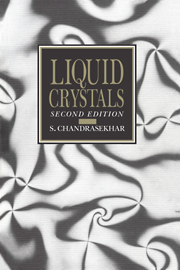Preface to the first edition
Published online by Cambridge University Press: 08 January 2010
Summary
‘I am at a loss to give a distinct idea of the nature of this liquid, and cannot do so without many words.’
The Narrative of Arthur Gordon Pym of Nantucket, Edgar Allan PoeThe foundations of the physics of liquid crystals were laid in the 1920s but, surprisingly, interest in these substances died down almost completely during the next three decades. The situation was summarized by F. C. Frank in his opening remarks at a Discussion of the Faraday Society in 1958: ‘After the Society's successful Discussion on liquid crystals in 1933, too many people, perhaps, drew the conclusion that the major puzzles were eliminated, and too few the equally valid conclusion that quantitative experimental work on liquid crystals offers powerfully direct information about molecular interactions in condensed phases.’ In the last few years there has been a resurgence of activity in this field, owing partly to the realization that liquid crystals have important uses in display technology.
An exposition of the physics of liquid crystals involves many disciplines: continuum mechanics, optics of anisotropic media, statistical physics, crystallography etc. In covering such a wide field it is difficult to define what precisely the reader is expected to know already. An attempt is made to present as far as possible a self-contained treatment of each of these different aspects of the subject. Naturally, discussion of some topics has had to be curtailed for reasons of space. For example, we have not dealt with lyotropic systems, whose complex structures are only just beginning to be elucidated; or the special applications of magnetic resonance techniques, as these have been adequately reviewed elsewhere; or the very recent results of neutron scattering experiments.
- Type
- Chapter
- Information
- Liquid Crystals , pp. xiii - xivPublisher: Cambridge University PressPrint publication year: 1992



